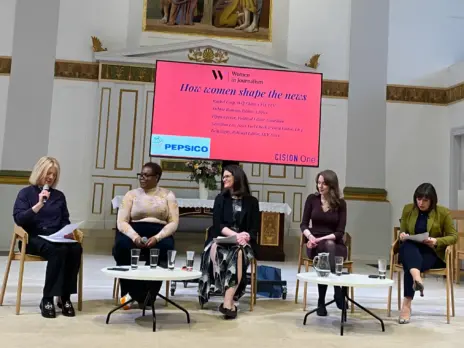
Over a lengthy career in journalism Roy Greenslade has written millions of words. But a handful out of a 4,000-word article in the British Journalism Review (and The Sunday Times) explaining his support for Irish republicanism and the IRA have now cast a shadow over all that went before.
In the piece, he talks about his friendship with Pat Doherty, who has been named in parliament as a former member of the Provisional IRA.
He states: “From very early on in our friendship [with Doherty and his wife], we four found ourselves in complete agreement about the right of the Irish people to engage in armed struggle.
“I came to accept that the fight between the forces of the state and a group of insurgents was unequal and therefore could not be fought on conventional terms. In other words, I supported the use of physical force.”
Greenslade’s beliefs have led to a chorus of outrage from the national newspapers which he criticised during 28 years as a media commentator for The Guardian.
But in addition to the concerns raised about his beliefs, some have flagged how his undeclared support for the IRA influenced his journalism. And The Guardian has issued an apology over one article which is the subject of a complaint.
Greenslade’s 2014 article criticising BBC coverage of IRA rape accusation
The Guardian has said it is reviewing all the articles about Northern Ireland written by Greenslade after receiving a complaint from Máiría Cahill.
She was the subject of a 2014 Guardian article by Greenslade which criticised a BBC Spotlight investigation into allegations the IRA forced her to keep quiet after being raped by one of its members.
Greenslade noted in a blog post that the programme was a “severe political embarrassment” for [then Sinn Fein president] Gerry Adams and said that the BBC was “under fire”.
Greenslade wrote: “It is claimed that the makers failed to take account of the fact that the woman, Maria (aka Maíria) Cahill, was a leading member of a dissident republican organisation with an anti-Sinn Féin agenda.
“It is further claimed that she remained a Sinn Féin supporter for many years after the alleged rape and only sought to go public with her sexual abuse allegations after she had turned against the organisation for political reasons…
“This lack of balance resulted in the Cahill story being accepted at face value across Ireland, where Adams and his party were forced on to the back foot as they tried to defend and explain the IRA’s actions.”
[Read more: Greenslade responds to outrage over IRA views: “I did nothing more than scores of journalists”]
He said the programme was “flawed by being overly one-sided”.
Cahill told the Daily Mail: “That Greenslade chose the angle he did is not surprising, but it is disgusting. No abuse disclosures should be weighed against victims’ previous politics.”
Greenslade was managing editor (news) of The Sunday Times in the late 1980s, editor of the Daily Mirror in 1990/1991 and a media commentator for The Guardian from 1992 to 2020.

Impress Trust in Journalism. Alan Rusbridger.
Picture: Impress
Former Guardian editor Alan Rusridger ‘wish he had been transparent at the time’
Guardian editor from 1995 to 2015 Alan Rusbridger yesterday told The Times: “All editors must wish he had been transparent at the time rather than leaving this until after he retired.
“The best route to trust is transparency and I suspect all the editors that Roy worked for, not to mention the readers, wish Roy had been more transparent about his own political beliefs.’
“I think it would serve readers well to append … the articles that remain online, noting what he has now made public about his beliefs and attachments.”
The Guardian Reader’s editor has now added a footnote to the Cahill piece saying: “Columnists are hired for their opinions but the readers’ editor considered that here the writer’s political position should have been indicated openly. The lack of disclosure was especially unfair to a vulnerable individual, and the Guardian has now apologised to Ms Cahill.”
Greenslade hoax calls to The Sunday Times
Another allegation against Greenslade came to light in the 2008 Nick Davies book Flat Earth News, but has been given new weight following the BJR piece.
Freelance journalist Marcus Leroux looked into this side of the story for Press Gazette.
In 1989 Roy Greenslade made a series of hoax phone calls to his own newspaper, writes Marcus Leroux . Putting on an Irish accent, he pretended to be the friend of an airline pilot who overheard SAS soldiers chatting about an operation in Gibraltar – Nick Davies reported in the 2008 boot Flat Earth News.
In 1988 the SAS killed three IRA terrorists in Gibraltar as they planned an attack.
Immediately the British press asked awkward questions, raising the possibility that the bombers could have been arrested rather than shot dead.
A Thames Television documentary, Death on the Rock, was particularly bold in poking holes in the government’s official account. Gibraltar was the latest in a series of suspected shoot-to-kill incidents in which the SAS ambushed republicans in the midst of their attacks.
The Sunday Times, under Andrew Neil, published what would today be described as a take-down of Death on the Rock.
A story by Insight, its investigative team, accused the programme of going beyond the evidence. The only trouble was that some of the Sunday Times Insight journalists knew from their own reporting that there were indeed serious problems with the government account. There was disquiet over how their reporting had been used in the final story.
Peter Hounam, a renowned investigative reporter, was among the journalists that harboured misgivings and he succeeded in getting a story out in the Sunday Times in 1989 that challenged the official version of events and implied that the IRA bombers could have been arrested but were killed in a pre-determined plan.
This is where Greenslade’s hoax calls come in.
In his recent article for the British Journalism Review he wrote that he used “subterfuge to direct a reporter towards evidence that contradicted the version of events that had taken hold within the newspaper”. In Flat Earth News, Davies wrote that “Greenslade’s Sinn Fein contacts gave him some useful information”, which he passed on using his fake identity and Irish accent, fearing that the information would be discounted if it were known to have come from Sinn Fein.
So what was the telling evidence from Sinn Fein that contradicted the government line?
“I merely pointed him towards an unidentified airline employee who had supposedly overheard a conversation between the troops involved”, Greenslade said by email. “It was a long-shot and Peter couldn’t stand it up.”
Hounam, now retired, said: “If Roy was feeding me hearsay about hearsay it would not have been of much help and I probably disregarded it.”
So Greenslade passed on unverified information, possibly misinformation, via an assumed identity for the benefit of Sinn Fein.
Hounam, who described Greenslade as a friend, said: “Setting aside my Gibraltar investigation, my concern is now that our wider investigations into the Troubles may have been compromised if, as Roy says, he was so close to paramilitaries.”
Greenslade’s allegations against former Sunday Times Northern Ireland editor Liam Clarke
In 1995, Greenslade wrote a piece condemning the Sunday Times for “bias and falsification” in its coverage of Northern Ireland.
This was post- the 1994 IRA ceasefire (but before the IRA resumed hostilities with a huge bomb in London’s Docklands in 1996 which killed two ). The Real IRA killed a further 29 in the Omagh bombing in 1998.
Greenslade reported anonymous claims that the Sunday Times was “hellbent on derailing the peace process” by publishing “patently false stories”.
He noted that Belfast editor Liam Clarke had written about Sinn Fein’s difficulty controlling the IRA post ceasefire.
Clarke had written: “Intelligence sources believe the ceasefire will be extended until Easter, when a final decision will be taken.”
Greenslade noted a further Clarke piece which said “a hardline faction of more than 50 terrorists is preparing to split from the IRA to begin a bombing campaign”.
The Docklands bombing the following year and the Omagh massacre in 1998, suggest Clarke’s reporting was prescient.
Greenslade noted that Clarke had attributed stories to “senior security officials” and “senior RUC detectives”.
Noting Clarke’s detailed reporting about the IRA’s movement of secret arms caches around Northern Ireland, he said: “How can the writer be so specific unless briefed directly by MI5?”
He said: “Another experienced NI correspondent claims the embellishment of ‘germs of truth’ is a classic British intelligence tactic.”
The thesis of Greenslade’s piece was The Sunday Times was allowing itself to be a tool of the British establishment: “Alarm about the continuing activities of the IRA and the possibility of the ceasefire breaking maintain fear among Irish readers, particularly among loyalist readers.”
Former Sunday Times managing editor Richard Caseby believes this was a dangerous and unwarranted slur and writes about the issue for the first time below.
Richard Caseby gives his opinion about Roy Greenslade’s 1995 attack on Liam Clarke
Roy Greenslade’s nostalgic musings that for decades he secretly supported the IRA’s murderous campaign hides a far darker and uglier truth, comments Richard Caseby.
Greenslade’s reporting put a Sunday Times journalist’s life in danger. He effectively marked him out for any rogue IRA gang seeking revenge on an easy victim. And for that alone, he should never be forgiven.
From 1986 to 1990 Greenslade was a Sunday Times news executive and one of the reporters who fell under his command was Liam Clarke, Northern Ireland Editor for two decades.
Liam was one of the most formidable and fearless journalists of his generation during the bloody Troubles and throughout the peace process.
He delivered scoops so consistently that his life was threatened time and again by the IRA. On one occasion in 1988 he dodged an IRA gang who hatched a plan to meet him in a pub – on the pretext of offering a story – and then abduct him.
As his line manager, Greenslade knew that the IRA threats to murder Liam were real. Such was their severity that the Sunday Times paid for elaborate security measures at his home. Liam regularly took refuge in London and Special Branch gave him a permit to carry a concealed handgun.
Despite the intrigue and pervasive threat, Liam was a humble and placid man. To the disquiet of colleagues, Liam’s pistol regularly fell out its holster with a thump whenever he bent down to pick up papers he’d dropped on the office floor.
In 1987, working on a secret assignment with the Insight team, Liam named Thomas “Slab” Murphy as the IRA’s chief of staff and accused him of being a gun runner and directing an IRA bombing campaign in Britain. Murphy sued the Sunday Times for libel and lost twice.
The then editor Andrew Neil bravely defended the story for over a decade at a cost of over a million pounds until the Irish Supreme Court dismissed Murphy’s final appeal in 1998.
One of the Sunday Times’s key witnesses during the trial was an ex-IRA member, Eamon Collins. The year after Slab Murphy lost his last appeal (1999), Collins was stabbed in the face and beaten to death by a republican gang while walking his dogs.
These were grim and dangerous times – though today forgotten by many.
For years on the Belfast beat, Liam was caught in the middle. On one side there was police harassment, on the other he had to defend himself against smears that he colluded with MI5. This was fuelled by Greenslade, who penned a 1,000-word character assassination of Liam in the Guardian which speculated that he “must have been briefed directly by MI5”.
“The allegations were wild, wrong and dangerous,” Liam wrote, the year after the IRA murdered his key witness, Collins.
“For a journalist living and working in Northern Ireland to be accused of collusion with the security forces is life-threatening. Once a lie is printed, it is repeated with regularity. Greenslade was unrepentant.
“The canard of involvement with British intelligence was seized upon by the IRA and Sinn Fein each time I wrote an article that embarrassed them.”
As Liam’s former boss, Greenslade knew that Liam was under threat from the IRA. He knew he had special security at his home. And he knew Liam carried a gun for his personal safety. And yet he still chose to undermine a fellow journalist to whom he once owed a duty of care.
As managing editor, I authorised new security measures for Liam’s home and Liam himself became more watchful. At times of direct threat he left the province to take cover in London. There was little else anyone could do.
Liam was born the son of a Presbyterian minister but when he died from cancer in 2015 he was a Buddhist.
At the time of Liam’s passing, Rory Godson, a former Ireland Editor of the paper and now the founder of Powerscourt, the city PR firm, said: “Lest we forget, it was dangerous being Liam Clarke. He moved house because people wanted to kill him. He was denounced by a noxious coalition in liberal London and Dublin…”
And at the heart of that noxious coalition in liberal London was Roy Greenslade, who was given free rein to drip his poison from the pages of The Guardian.
Richard Caseby is founder of Caseman Communications (www.casemancomms.com) and a former managing editor of The Sunday Times
Roy Greenslade declined to comment further beyond what he said to Press Gazette earlier this week: “The furore underlines the main point of my article: to have come clean in the 1970s with my beliefs would have rendered me unemployable.
“I did nothing more than the scores of journalists who keep their political views to themselves. My opinions did not affect my journalistic work, nor did they affect my university teaching. As many of my more attentive students would surely recall, I was open about being a republican.”
Email pged@pressgazette.co.uk to point out mistakes, provide story tips or send in a letter for publication on our "Letters Page" blog







